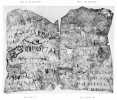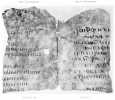SOME INFORMATION
CONCERNING
THE GOTHIC NEW TESTAMENT
portions of this page, copyrighted © 2006, by Mr. Gary S. Dykes
|
The Gothic version is basically a translation made by a Bishop Ulfilas from Greek manuscripts. The translation was made in about A.D. 360. Ulfilas's parents may have been carried off as captives from Cappodocia, by the invading Goths, circa A.D. 264. Hence the impetus for Ulfilas to act as a missionary to the Goths. He was bishop of the Goths in 341 and apparently remained so until his death in 383. He dwelt in Constantinople from A. D. 336 to 341, there he was consecrated Bishop to the Goths north of the Danube in 341. His personal theology favored Arianism, but to the degree this system affected his translation work is not clear. Yet his Arianism certainly affected all of the Gothic peoples! It is reputed that he translated all of the Bible into Gothic, with the exception of the four books of Kings. His translation is valuable as it provides a fine translation of the early Antiochian text, before it was refined into the Standard Byzantine Text (as per my opinion). All surviving copies of the Gothic texts appear to have been copied during the Lombardic occupation of Italy in the 6th century. However Codex Giessenense (fragmentary) may have been written in Egypt (shown below).
|
For a complete HTML edition of Streitberg's Gothic text click on this link STREITBERG, and note who kindly provides this file! |
|
TITLE OF FACSIMILE EDITION: WULFILAE CODICES AMBROSIANI RESCRIPTI, Jano De Vries, Augustae Taurinorum, 1936. This is somewhat of a rare book, so do not expect to find it in your local library! However most of its images are quite useless for critical purposes, as the underwritings of the palimpsests are not very visible. Two sample images are provided, to the right; image #1 is Codex A (I Cor. 16:5-11). Image #2, Codex B, (Philippians 2:22-28).
|
|
|
TITLE OF FACSIMILE EDITION: Of the Codex Argenteus we have: CODEX ARGENTEUS UPSALIENSIS, Iussu senatus Universitatis phototypice editus (Uppsala: University, 1927). A work based on UV and X-ray photographs, often with two photographs of the same page. These images are somewhat useful.
|
|
|
TITLE OF TEXT EDITION: E. Bernhardt, 1875. With a great introduction! a sample page is on the right. Vulfila oder Die Gotische Bibel, Halle - 1875
|
 |
|
TITLE OF ANOTHER TEXT EDITION: W. Streitberg, 1950. A sample page is on the right. Die Gotische Bibel, Heidelberg - 1950
|
 |
|
TITLE OF ANOTHER TEXT EDITION: (recommended!) Harder to find, but an excellent text of the Gothic is: The First Germanic Bible. By Georg Hubert Balg. It is for the English reader, and has a very good glossary/dictionary. It does not present a reconstructed Greek text, which is normally NOT needed. An inexpensive CD (scanned copy) is available here: www.solascripturapublishing.com [It is a good scanned copy!!] Image #1 is from Balg's text as on the CD, #2 shows a sample page from his glossary.
|
 1 1
 2
2 |
|
Gothic-Latin Codex Fragment: Codex Gissenense. Date A.D. 450 - 550. On parchment. Found near Antinoë, Egypt in 1907. Fragment destroyed in 1945 (water damage). Contains Luke 23 and 24 (portions thereof). The date of the 6th century is the usual one, although Glaue dates it in the 5th. Most of those who date it in the 6th do so based upon historical reasons (dates of the Lombardic occupation of Italy). However the manuscript could be earlier. The Latin script appears to me to be executed by an Egyptian scribe, probably in Egypt. (popular opinion has the provenance as in Lombardic Italy). These images are all that remain of the original (Lowe has also a sample in volume viii, # 1200, Codices Latini Antiquiores). Along with the rare images, I have the 1910 ZNW journal text with the same included images. This digital reproduction is of good resolution. Is exclusive to this site. 41 pages PDF. About 26.7 MB. Text is in German!! To view or download the PDF file, click on the PDF icon.
|
|
|
|





